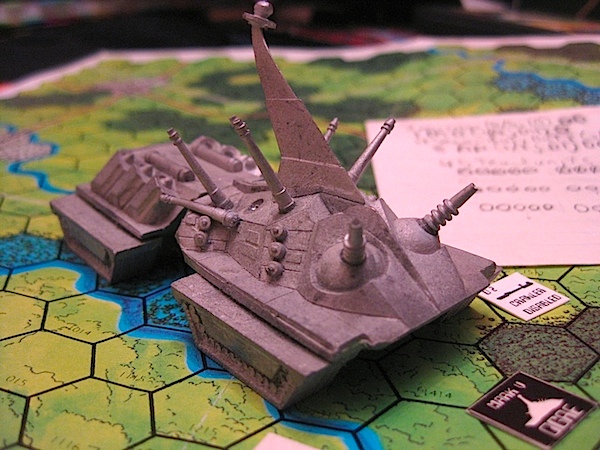Every day, a new viral share sparks through the Internet, showing robots and drones and flying robot drones playing tennis while singing the theme to James Bond. At the same time we’ve seen shares of area-denying heat rays and anti-speech guns that disrupt talking … and it all starts to sound a little scary. Vijay Kumar’s TED talk on swarms of flying robots reminded me that I’ve been saying privately to friends for years years that the military applications of flying robots are coming … for the first time, we’ll have a technology that can replace infantry at taking and holding ground.
The four elements of military power are infantry, who take and hold ground, cavalry, which break up infantry, artillery, which softens up positions from a distance, and supply, which moves the first three elements into position. In our current world those are still human infantry, human piloted tanks, human piloted bombers, and human piloted aircraft carriers.
We already have automated drones for human-free (though human-controlled) artillery strikes. Soon we will have the capacity to have webs of armed flying robots acting as human-free infantry holding ground. Autonomous armored vehicles acting as human-free cavalry are farther out, because the ground is a harder problem than the air, but they can’t be too far in the future. Aircraft carriers and home bases we can assume can be manned for a while.
So then soon, into cities that have been softened up by drone strikes, we’ll have large tanks like OGREs trundling in serving as refueling stations for armies of armored flying helicopters who will spread out to control the ground. No longer will we need to throw lives away to hold a city … we’ll be able to do it from a distance with robots. One of the reasons I love The Phantom Menace is that is shows this kind of military force in action.
Once a city is taken, drones can be used for more than surveillance … a drone with the ability to track a person can become a flying assassin, or at least force someone to ditch any networked technology. Perhaps they’ll even be able to loot items or, if they’re large and able enough, even kidnap people.
It would be enormously difficult to fight such a robotic force. A robotic enemy can use a heat ray to deny people access to an area or a noise gun to flush them out. Camera detection technology can be used to flush out anyone trying to deploy countermeasures. Radar flashlights can be used to find hiding humans by their heartbeats, speech jammers can be used to prevent them from coordinating, and face detection you probably have on your phone will work against anyone venturing out in the open. I’ve seen a face detector in the lab combined with a targeting system and a nerf gun almost nail someone … and now a similar system is in the wild. The system could destroy anyone who had a face.
And don’t get me started on terminators and powered armor.
Now, I am a futurist, transhumanist, Ph.D. in artificial intelligence, very interested in promoting a better future … but all too familiar with false prophecies of the field. Critics of futurism are fond of pointing out that many glistening promises of the future have never come to pass. But we don’t need a full success for these technologies to be deployed. Many of the pieces already exist, and even if they’re partially deployed, partially effective mostly controlled by humans … they could be awesome weapons of warfare … or repression.
The future of warfare is coming. And it’s scary. I’d say I don’t think we can stop it, and on one level I don’t … but we’ve had some success in turning back from poison gas, are making progress on land mines, and maybe even nuclear weapons. So it is possible to step back from the brink … but I don’t want to throw the baby out with the bathwater the way we seem to have done with nuclear power (to the climate’s great detriment). As my friend Jim Davies said to me, 99% of the technologies we’d need to build killbots have nothing to do with killbots, and could do great good.
In the Future of Warfare series on this blog, I’m going to monitor developing weapons trends, both military systems and civilian technologies, realistic and unrealistic, in production and under speculation. I’m going to try to apply my science fiction writer’s hat to imagine possible weapons systems, my scientist’s hat to explore the technologies to build them, and my skeptic’s hat to help discard the ones that don’t hold water. Hint: it’s highly likely people will invent new ways to hurt each other … but highly unlikely that Skynet will decide our fate in a millisecond.
A bright future awaits us in the offworld colonies … but if we want to get there, we need to be careful about the building blocks we use.
-the Centaur
Pictured: an OGRE miniature. This blogpost is an expansion of an earlier Google+ post.
